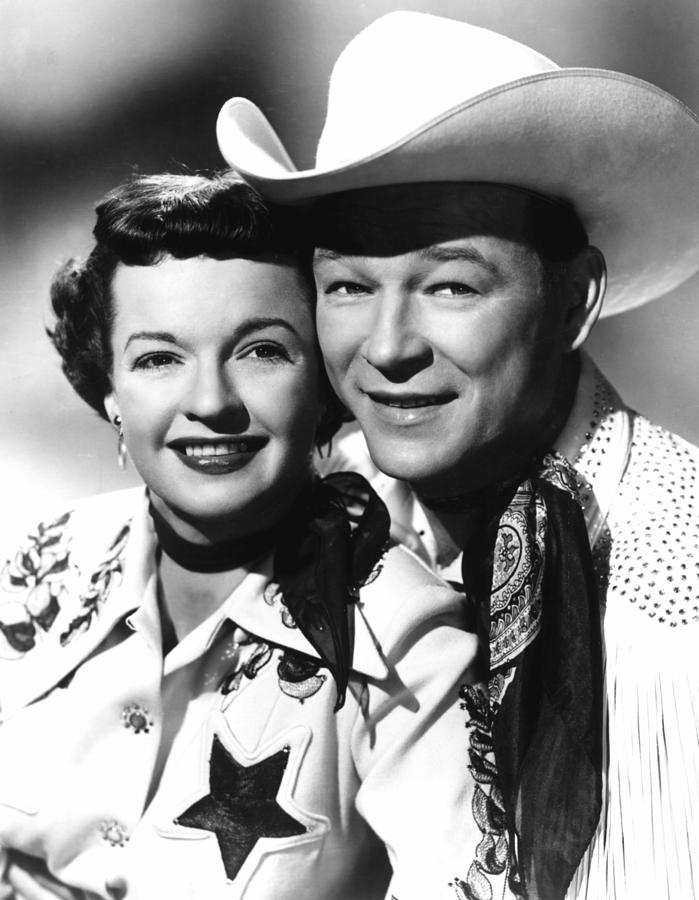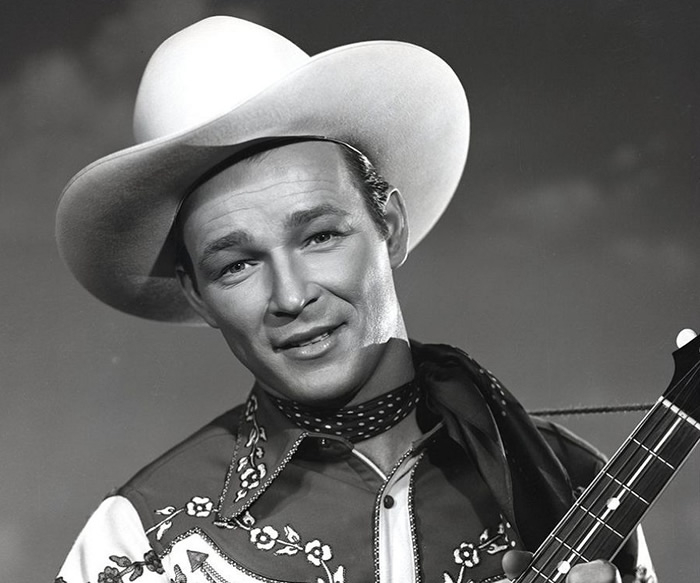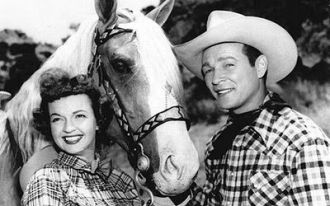Roy Rogers, a shoe factory worker's son from Cincinnati who rode a golden palomino and a harmonious voice to fame as Hollywood's most beloved and quintessential singing cowboy, died yesterday at his ranch in Apple Valley near Victorville, Calif. He was 86.
With a guitar propped on his knee and six-shooters holstered on his hips, the crinkly-eyed Mr. Rogers tamed the West with his characteristic heart and compassion, becoming a hero to the staunch fans of his television show and nearly 100 movies, and gaining enough cachet to have a roast-beef fast-food chain named after him. A practitioner of minimal violence, he much preferred to shoot the pistol out of a gunslinger's hand than actually harm the man, his vileness notwithstanding.
In midcentury America, when celluloid prairie life captivated the nation, the redoubtable Mr. Rogers was the ''King of the Cowboys,'' his wife and co-star, Dale Evans, the ''Queen of the West'' and Trigger, Mr. Roger's wonder horse, the ''Smartest Horse in the Movies.''
Following their exploits on the Double-R-Bar Ranch, along with those of Buttermilk, Miss Evans's buckskin horse, and Bullet, their German shepherd, was an essential rite of growing up. Children ate from Roy Rogers lunch boxes, played with Roy Rogers cutout dolls and slept on Roy Rogers bedsheets. Who could forget the memory of Trigger rearing up majestically while Roy Rogers waves toward the cerulean Western sky? Who couldn't sing along as Roy and Dale shook off trail dust and broke into ''Happy Trails to You,'' their signature song that Miss Evans wrote? Who didn't ache for a chance to meet the hero in the flesh and drawl, ''Howdy, pardner''?
''Today there will be a lot of sad and grateful Americans, especially of my generation, because of his career,'' said President Clinton, a boyhood fan of Mr. Rogers.
He was an outsized and, for a cowpoke, an immaculately dressed figure. There were his double-creased white cowboy hat, the flowing kerchief knotted at the side of his neck, the gabardine cowboy shirt, the western-cut trousers and those shiny, pointed cowboy boots. He embodied unmistakably wholesome values and evoked a vanishing and idealized America, when men tipped their hats to the ladies and sang sentimental ballads around the bone-warming glow of a campfire.
At the pinnacle of his fame in the decade after the end of World War II, Mr. Rogers was consistently the most popular western star in America, succeeding Gene Autry and William (Hopalong Cassidy) Boyd in the genre. A survey conducted by Life magazine among children found that when they were asked whom they most wanted to emulate, Mr. Rogers matched Franklin D. Roosevelt and Abraham Lincoln.
Mr. Rogers gladly shared the limelight with his wife, who often accompanied him in singing and frequently steered him out of harm's way; with George (Gabby) Hayes, his garrulous sidekick, and with Trigger. Mr. Rogers discovered Trigger among the many horses auditioning for the role of his trusty stallion in ''Under Western Stars,'' the movie that began his career in 1938.
''I got on him and rode him 100 yards and never looked at another horse,'' Mr. Rogers recalled. He described Trigger, who cost $2,500 in 1938, as ''the best thing that ever happened'' to him. Under Mr. Rogers's tutelage, the horse learned a lengthy repertoire of tricks. He could untie ropes, sit in a chair, fire a gun and add and subtract.
When Trigger died in 1965 at age 33, the Smithsonian Institution wanted to display him in Washington. Mr. Rogers could not bear the separation. He had him mounted (not stuffed) and he remains, in his rearing hind-leg pose, the most popular attraction at the Roy Rogers-Dale Evans Museum in Victorville.
Roy Rogers starred in 91 feature motion pictures and 102 halfhour television films. For many Americans, the titles of his films are imprinted on their memories: ''In Old Caliente,'' ''The Arizona Kid,'' ''Days of Jesse James,'' ''Robin Hood of the Pecos,'' ''Springtime in the Sierras,'' ''Pals of the Golden West.'' His own favorite was ''My Pal Trigger.''
He also starred in touring rodeos, made records and developed extensive business interests in real estate, music publishing and fast-food restaurants. Children of today are doubtlessly more aware of Mr. Rogers as a roast-beef sandwich than as a cowboy. In 1968, the Roy Rogers Family Restaurants, a fast-food chain, was developed by the Marriott Corporation in partnership with Mr. Rogers. He, in turn, became a Marriott stockholder. The chain, which grew to upward of 800 restaurants, was sold in 1990 to Hardee's, which sold it last July to the MRO Mid-Atlantic Corporation. It has shrunk to about 110 restaurants. As recently as 1995, Mr. Rogers appeared in an ad campaign for the roast-beef sandwiches. He recited some poetry.
In the late 1940's and early 50's, more than 2,000 fan clubs declared their fidelity to the cowboy couple. More than 400 licensed products bore their names and visages, and Mr. Rogers's picture adorned 2.5 billion boxes of cereal.
When not roping and shooting straighter than anyone else, Mr. Rogers and Miss Evans supported Christian charities and the religious programs of the Rev. Billy Graham and Bill Bright, who founded the Campus Crusade for Christ. Mr. Rogers was also involved in programs to aid the handicapped and chronically ill, especially children.
Growing up, Mr. Rogers was emphatically pragmatic, and his interest was in teeth.
He was born Leonard Franklin Slye on Nov. 5, 1911, one of four children and the only son of Andrew E. and Hattie Womack Slye. His father worked for the United States Shoe Company in Cincinnati; his mother was a homemaker who loved music. Their house stood about where second base now is at Riverfront Stadium, where the Cincinnati Reds play baseball. The family was of modest means. Mr. Rogers used to say, ''I hardly wore shoes until I was almost grown.''
Once he became a star, much was made of Mr. Rogers's Choctaw Indian blood from his mother's side. Indians basked in his accomplishments and in 1967 he was named ''outstanding Indian citizen of the year'' by a group of Western tribes.
Though Mr. Rogers admired cowboy stars from the silent-screen era, he did not envision himself galloping across the prairie. His ambition was to become a dentist, a profession, he reasoned, that everyone needed.
However, his absorption with the culture of the West began to grow in 1919, when Andrew Slye moved his family from the city to a small farm in Duck Run, Ohio. There Mr. Rogers learned to ride a mule, acquired the ranch-hand skills and gained the familiarity with animals that he would eventually apply to the Hollywood range.
Later, the family returned to Cincinnati. To ease Andrew Slye's money problems, Mr. Rogers quit school to work with his father in the shoe company. In 1929, as the stock market was poised to crash, Mr. Rogers moved again, this time to California to pick fruit. Mr. Rogers spent many evenings playing the guitar and singing for fellow farm workers.
To supplement his meager income, Mr. Rogers formed a singing duo with a cousin, Stanley Slye, and they performed at parties and square dances.
Mr. Rogers made his radio debut in 1931 as a member of Tom Murray's Hollywood Hillbillies. He also performed with groups like the International Cowboys and the O-Bar-O Cowboys. For awhile, he was known as Cactus Mac.
Joined by Bob Nolan, the composer of ''Tumbling Tumbleweeds,'' Mr. Rogers assembled another group. A radio announcer got their name mixed up and called them ''the Sons of the Pioneers.'' It stuck, and in the middle 1930's they began to make transcriptions of romantic cowboy ballads. ''Tumbling Tumbleweeds'' appealed even to people with no affinity for country-western music.
Beginning in 1935, the Sons of the Pioneers began to show up in the movies. They appeared briefly with Bing Crosby in ''Rhythm on the Range'' and in Gene Autry's first movie, ''Tumbling Tumbleweeds.''
Cowboys with musical abilities were the rage in the Depression years and none outshone Mr. Autry. But when Mr. Autry made clear to Republic Studios that he wanted a hefty raise, the studio began searching for another cowpuncher.
In 1937 Mr. Rogers auditioned for the star role in a movie called ''Washington Cowboy,'' landing the part that had been written for Mr. Autry. The name of the film was changed to ''Under Western Stars.'' Instead of Len Slye, Republic planned to rename him Dick Weston, until they settled on Roy Rogers, his name from then on.
Bosley Crowther, reviewing ''Under Western Stars'' for The New York Times, wrote that the newcomer had ''a drawl like Gary Cooper'' and ''a smile like Shirley Temple.'' Republic recommended he use drops to widen his eyes, but moviegoers didn't mind his crinkly expression. With Mr. Autry off to war as a flier, Mr. Rogers became ''King of the Cowboys'' in 1943. He never relinquished the title.
Mr. Rogers appeared as a low-key, well-intentioned, dependable good guy. He never bragged or postured. Always protective of the weak and brave, he was kind to animals, God-fearing and slow to anger. He also sang pleasantly and in one 1944 film, ''Hollywood Canteen,'' introduced Cole Porter's ''Don't Fence Me In.''
Mr. Rogers's first wife was Arlene Wilkins, whom he met in 1931 while on the road with a singing group. Broke, he agreed to sing ''The Swiss Yodel'' for a lemon pie. She made it. They married in 1936. She died of an embolism days after she gave birth to their son, Roy Rogers Jr., in 1946.
In 1944 he met Miss Evans, cast opposite him in ''The Cowboy and the Senorita.'' They were married on New Year's Eve in 1947 and she remained until he died ''my sweetheart and hunting and fishing partner all wrapped up into one.''
Devoted as they were, they never kissed on the screen. Mr. Rogers frowned on such public displays and was ever mindful that he was a potent role model for millions of children. They made several films together, and in their television series for NBC, ''The Roy Rogers Show,'' which ran from 1951 to 1957, Miss Evans joined Mr. Rogers after every show to sing ''Happy Trails.'' That theme was a title of their autobiography, published in 1979.
When Mr. Rogers married Miss Evans, he had three children, an adopted daughter named Cheryl, another daughter, Linda Lou, and Roy Rogers Jr. She was a twice-married actress with a son, Thomas Frederick Fox Jr.
In raising a family, the couple endured heartbreaks. Miss Evans and Mr. Rogers had a daughter, Robin Elizabeth, who was born with Down's syndrome and died before her second birthday. They had kept her at home, uncommon in those days, and rejected any thought that they keep her illness a secret in accordance with a show-business notion that audiences would recoil if a perfect couple had an imperfect child. In 1953, Miss Evans wrote a best-selling inspirational book about their daughter called ''Angel Unaware.''
To help soothe their grief, the couple adopted a Korean War orphan they named Deborah Lee. In 1964, when she was 12, she was killed when a church bus collided with a car. The next year, John David (Sandy) Rogers, an abused child whom they adopted after a visit to an orphanage, choked to death in a military hospital in Germany, where he was serving in the Army. After he died, Miss Evans wrote a book, ''Salute to Sandy.''
Miss Evans and Mr. Rogers adopted one other child, Dodie, an Indian whom Miss Evans met while touring an orphanage, and fostered Marion, who was 6 when they found her in Scotland.
In addition to Miss Evans, Mr. Rogers is survived by his children, Roy Rogers Jr., Cheryl Barnett, Linda Lou Johnson, Dodie Sailors, Marion Swift and Tom Fox, 15 grandchildren and 33 great-grandchildren.
A memorial service will be held at the Church of the Valley in Apple Valley.
Roy Rogers Jr., known as Dusty, serves as curator of the Roy Rogers-Dale Evans Museum, set at the edge of the Mojave Desert and seven miles from the Rogers-Evans ranch, named the Double-R-Bar like the one on their television series. Mr. Rogers would often visit the museum and converse with visitors. He continued to wear his white Stetson, his gabardine shirts and his silver-and-leather belts. Even though his legs ached and he would have been more at ease in sneakers, he always pulled on his pointy boots with the high heels.
To the end, Roy Rogers remained a humble and simple man. ''I'm an introvert at heart,'' he once said. Commenting on the adversity in his life, he wrote, ''If there were no valleys of sadness and death, we could never really appreciate the sunshine of happiness on the mountaintop.''
ADVERTISEMENT
BY
Looking for more information?
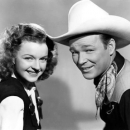
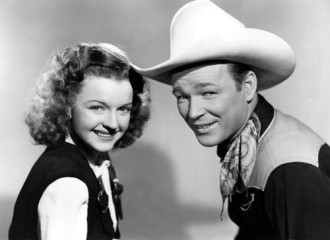
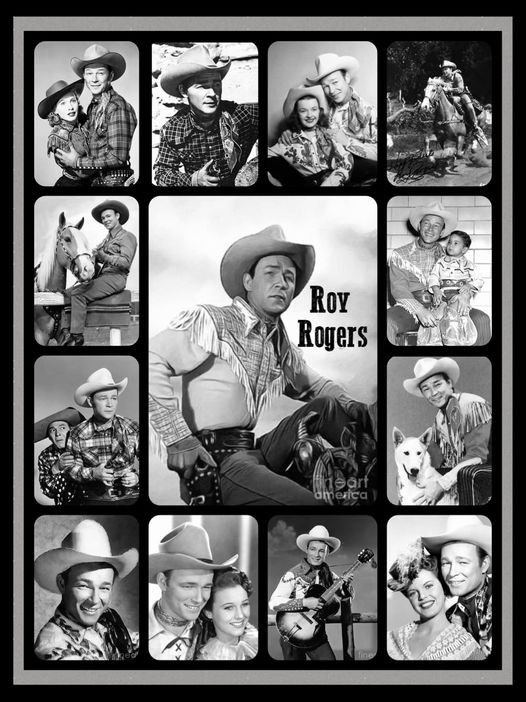
 Amanda S. Stevenson
Amanda S. Stevenson 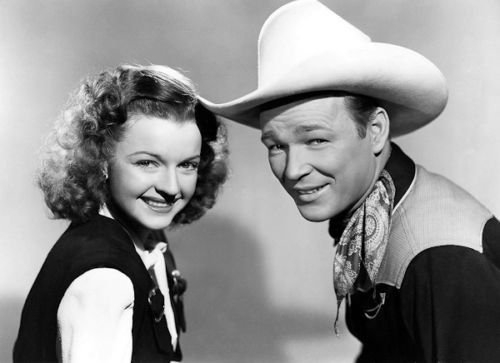
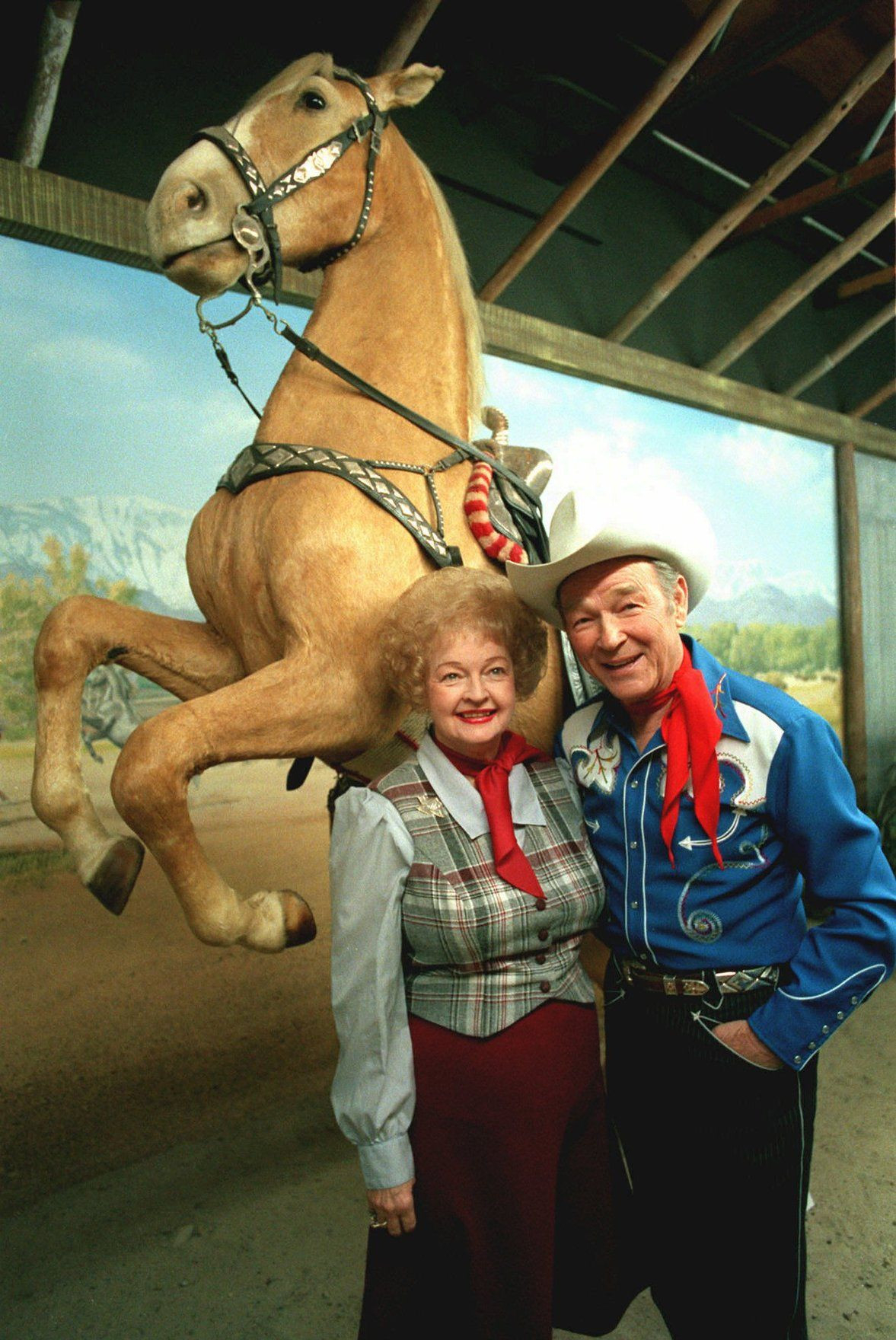
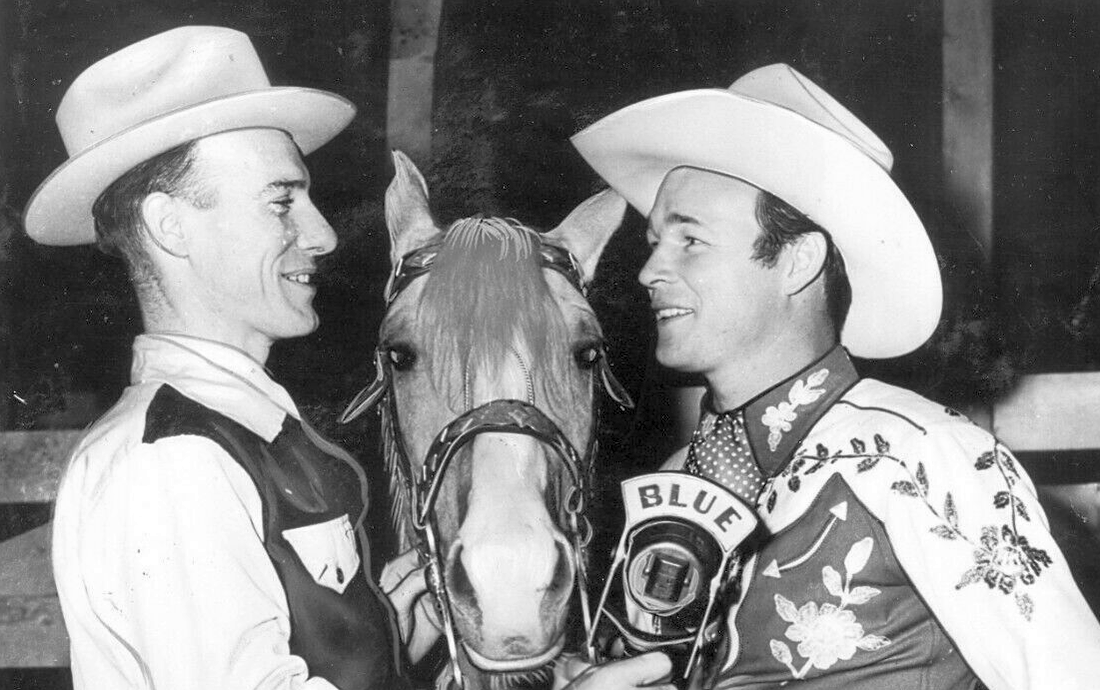
 David Jackson
David Jackson 